RÉCHY/BECS-DE-BOSSON (VS)
Active rock glacier with composite morphology (lobes, push-moraines, historical glacier forefield)
Elevation: 2640-2850m - Massif: Alpes Valaisannes - Commune: Mont-Noble (VS)
The study of the Becs-de-Bosson rock glacier started in 1986. At first, the main interest was to assess the presence, the distribution and the evolution of permafrost inside the rock glacier. Later, position measurements (geodesy and photogrammetry), ground and air temperature monitoring as well as hydrologic measurements were conducted. Tracer experiments took place between 1986 and 1990 and in 2012. Hence, the runoff through the rock glacier was found to be quite slow (several days to months). Furthermore, the absence of permafrost and the resulting lack of movement are to be noted within the glacier roots which are to be attributed to a small glacier, present during the Little Ice Age. On the edge of the former extent of the glacier a set of push-moraines was formed. Back-creeping movements of these frozen deposits still take place today. Further down, the deformation field of the rock glacier is of a complex nature. Maximum speeds locally exceeded two meters per year for instance between 2013 and 2017 while the main front moved only a few centimeters. Some rock temperature sensors have been installed on the head walls of the Becs-de-Bosson summit for the time period 2004 to 2013. This field site is part of the “Kinematics” section of the PERMOS (PERmafrost MOnitoring in Switzerland) monitoring network.
-
Measurements and observations
Thermal (Surface temperature: GST, BTS)
Geodetic (GNSS, permanent GPS)
Remote Sensing (aerial images)
Geophysics (electrical resistivity, refraction seismics )
Hydrological (tracing, discharge)
Weather station, snow stake -
Figures
Frontal part of the Becs-de-Bosson rock glacier: in the foreground, the very active secondary lobe L2 and, under the snow, its periglacial frontal push-moraine L2b; in the background, the main lobe L1 whose only the upper half part is moving fast (picture 2011).
Historical, partially back-creeping push-moraines in the rooting zone of the Becs-de-Bosson rock glacier (orographic left side) (picture 2005).
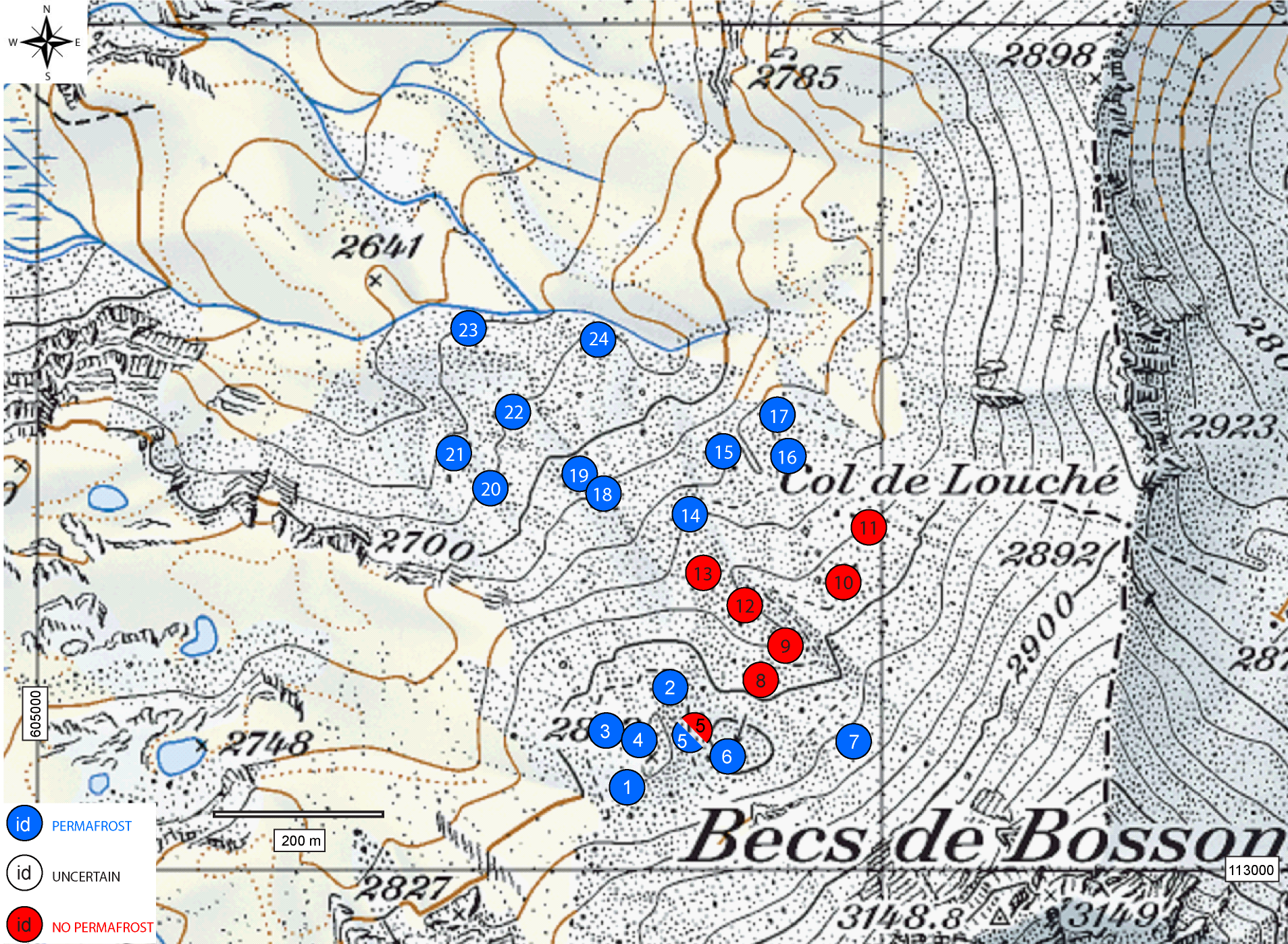
Presence/absence of permafrost based on electrical resistivity measurements (data: 1990, 2002).

Measured horizontal flow field (mean annual velocity).
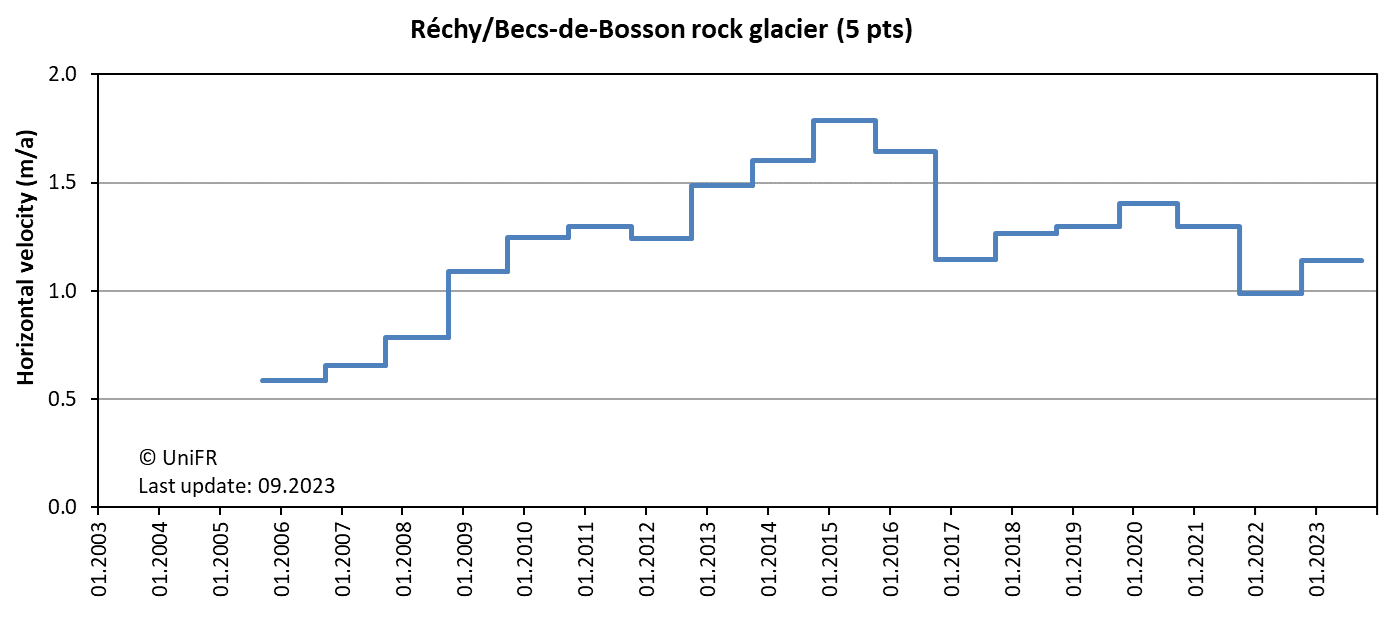
Annual horizontal surface velocity. Mean of a set of 6 points selected in various parts of the rock glacier.
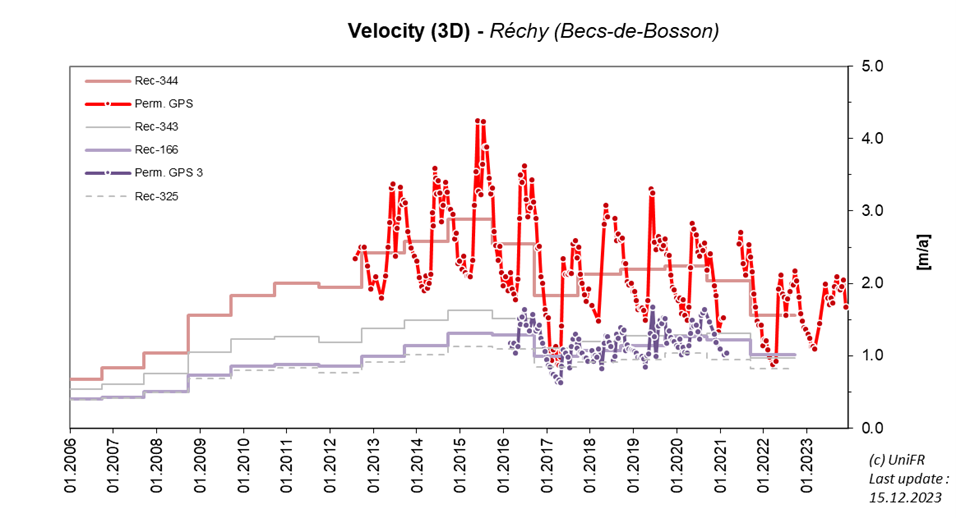
Velocities derived from permanent GNSS (GPS) stations located in the central part of the landform.
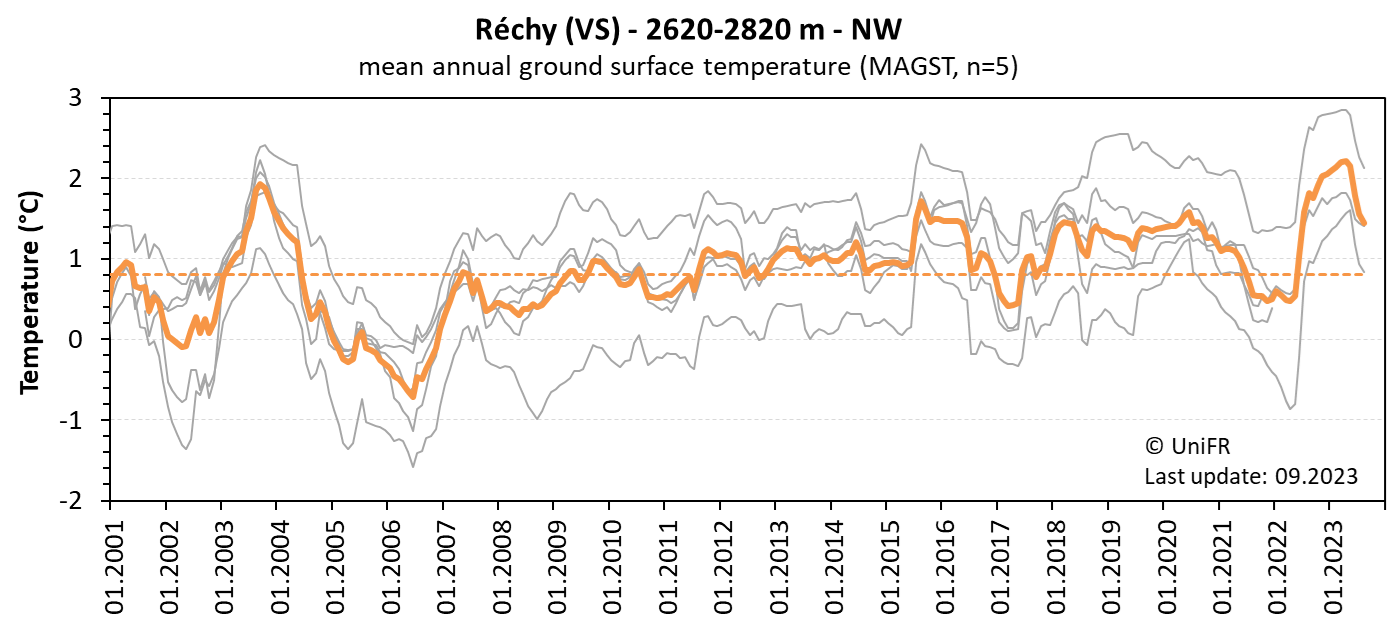
Mean annual ground surface temperature. The orange curve represents the mean temperature of the n sensors installed on the site (grey curves). The orange dotted line is the mean temperature observed since the beginning of the measurements.
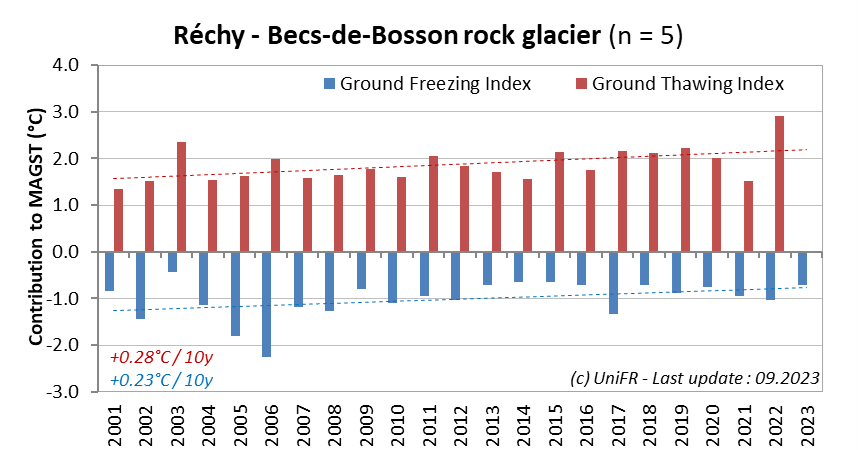
Contribution of the annual Ground Freezing (sum of all daily mean values < 0°C) and Ground Thawing (>0°C) Indexes to the mean annual ground surface temperature (MAGST) on a set of selected locations (n) on the site with indication of the respective trend since the beginning of the time series. Or : how cold was the winter and how warm was the summer at the surface of the ground ?

Mean annual dates of the start and end of the snowmelt period (zero curtain phase). Mean of n sensors localized on permafrost terrain.
-
Collaboration
GEOSAT SA
-
Publications
Strozzi, T., Caduff, R., Jones, N., Barboux, C., Delaloye, R., Bodin X., Kääb, A., Mätzler, E., Schrott, L. (2020). Monitoring Rock Glacier Kinematics with Satellite Synthetic Aperture Radar. Remote Sensing, 12, 559. DOI: 10.3390/rs12030559
PERMOS 2019. Permafrost in Switzerland 2014/2015 to 2017/2018. Noetzli, J., Pellet, C., and Staub, B. (eds.), Glaciological Report (Permafrost) No. 16-19 of the Cryospheric Commission of the Swiss Academy of Sciences, 104 pp, DOI:10.13093/permos-rep-2019-16-19.
Mewes, B., Hilbich, C., Delaloye, R., and Hauck, C. (2017). Resolution capacity of geophysical monitoring regarding permafrost degradation induced by hydrological processes, The Cryosphere, 11, 2957-2974. DOI: 10.5194/tc-11-2957-2017
Delaloye, R. & Staub., B. (2016). Seasonal variations of rock glacier creep: time series observations from the Western Swiss Alps. In: Günther, F. and Morgenstern, A. (Eds.) (2016): XI. International Conference On Permafrost – Book of Abstracts, 20 – 24 June 2016, Potsdam, Germany. Bibliothek Wissenschaftspark Albert Einstein. 22-23. (pdf)
PERMOS (2016). Permafrost in Switzerland 2010/2011 to 2013/2014. Noetzli, J., Luethi, R., and Staub, B. (eds.), Glaciological Report (Permafrost) No. 12-15 of the Cryospheric Commission of the Swiss Academy of Sciences, 85 pp. (pdf)
Staub, B. & Delaloye, R. (2016): Using Near-Surface Ground Temperature Data to Derive Snow Insulation and Melt Indices for Mountain Permafrost Applications. Permafrost and Periglacial Processes. DOI: 10.1002/ppp.1890.
Staub, B., Lambiel, C. and Delaloye, R. (2016). Rock glacier creep as a thermally-driven phenomenon: A decade of inter-annual observations from the Swiss Alps. In: Günther, F. and Morgenstern, A. (Eds.) (2016): XI. International Conference On Permafrost – Book of Abstracts, 20 – 24 June 2016, Potsdam, Germany. Bibliothek Wissenschaftspark Albert Einstein. 96-97. (pdf)
Mari, S. (2014). Studio e insegnamento dei movimenti di versante in ambiente periglaciale in Ticino e nella Regione Gottardo. Tesi di dottorato, Università di Friborgo, 375 pp. (pdf)
Mari, S., Scapozza, C., Pera, S. and Delaloye, R. (2013). Prove di multitracciamento di ghiacciai rocciosi e ambienti periglaciali nel Vallon de Réchy (VS) e nella Valle di Sceru (TI). Bollettino della Società ticinese di scienze naturali, 101, 2013, pp. 13-20 (ISSN 0379-1254). (pdf)
PERMOS (2013). Permafrost in Switzerland 2008/2009 and 2009/2010. Noetzli, J. (ed.), Glaciological Report (Permafrost) No. 10/11 of the Cryospheric Commission of the Swiss Academy of Sciences, 80 pp. (pdf)
Delaloye, R., Lambiel, C. and Gärtner-Roer, I. (2010). Overview of rock glacier kinematics research in the Swiss Alps. Seasonal rhythm, interannual variations and trends over several decades. Geographica Helvetica, 65/2, 135-145. DOI: 10.5194/gh-65-135-2010
Delaloye, R., Perruchoud, E., Avian, M., Kaufmann, V., Bodin, X., Hausmann, H., Ikeda, A., Kääb, A., Kellerer-Pirklbauer, A., Krainer, K., Lambiel, C., Mihajlovic, D., Staub, B., Roer, I. & Thibert, E. (2008). Recent interannual variations of rockglaciers creep in the European Alps, Proceedings of the Ninth International Conference on Permafrost, July 2008, Fairbanks, Alaska, 1, 343-348. (pdf)
Perruchoud, E. (2007). Suivi par GPS des déformations de glaciers rocheux et moraines de poussée dans les Alpes valaisannes. Travail de diplôme, Institut de Géographie, Université de Fribourg (CH), non publié, in french, 113 p. (pdf)
Perruchoud, E., Delaloye, R. (2007). Short-term changes in surface velocities on the Becs-de-Bosson rock glacier (western Swiss Alps). Proceedings HMRSC-IX, Graz, 14-15 Sept. 2006, Grazer Schriften der Geographie und Raumforschung 43, 131-136. (pdf)
Kääb A. (2005) Remote sensing of mountain glaciers and permafrost creep. Schriftenreihe Physische Geographie. 48, 266 pages. ISBN 3 85543 244 9.
Delaloye, R. (2004). Contribution à l’étude du pergélisol de montagne en zone marginale. PhD thesis, Fac. Sciences, Univ. Fribourg, GeoFocus 10 (pdf)
Lambiel, C. & Delaloye, R. (2004). Contribution of real-time kinematic GPS in the study of creeping mountain permafrost: examples from the Western Swiss Alps. Perm. Perigl. Proc. Vol. 15/3, 229-241. DOI: 10.1002/ppp.496
Delaloye R., Métrailler S. and Lugon R. (2003): Evolution du pergélisol dans les complexes glacier/glacier rocheux des Becs-de-Bosson et de Lona (Nax, St-Martin, VS). Bulletin de la Murithienne, 121, 7-20.
Lugon, R. & Delaloye, R. (2001). Modelling alpine permafrost distribution, Val de Réchy, Valais Alps (Switzerland).Norwegian Journal of Geography. Vol. 55/4, 224-229.
Gardaz J-M. (1998): Permafrost Prospecting, Periglacial and Rock Glacier Hydrology in Mountain Areas. Case studies in the Valais Alps, Switzerland. Thèse. Fac. Sciences, Univ. Fribourg, 184pp.
Lugon R. (1998): Evolution du pergélisol alpin face aux changements climatiques, études de cas dans les Alpes valaisannes (Suisse). Thèse. Fac. Sciences, Univ. Fribourg.
Tenthorey G. (1994): Hydrologie liée aux glaciers rocheux, Haut-Val de Réchy (Nax, VS) Bulletin de la Murithienne, 112, 97-116.
Tenthorey (1993). Paysage géomorphologique du Haut-Val de Réchy (Valais, Suisse) et hydrologie liée aux glaciers rocheux. Thèse de doctorat, Institut de Géographie, Université de Fribourg (CH), non publié, 291 p. (pdf)
Tenthorey G. (1992): Perennial névés and the hydrology of rock glacier. Permafrost and Periglacial Processes, 3(3), 247-252.
Tenthorey G. (1989): Etude géomorphologique et hydrologique des terrains périglaciaires du haut Val de Réchy (Nax, VS): présentation du projet. Bulletin de la Murithienne, 107, 59-67.
Monbaron M. and Tenthorey G. (1988-1989): Hydrologie en zone périglaciaire au Vallon de Réchy (VS). Essai de coloration sur un glacier rocheux. Bulletin de la Société neuchâteloise de géographie, 32-33, 117-128.
Berweger R and Lack A. (1986): Diplomarbeit in Photogrammetrie: Blockgletscher-vermessung im Val de Réchy. Ingenieurschule beider Basel, unpublished.
Lencewicz S. (1918): Morphologie du Val de Réchy dans les Alpes Pennines. Travaux de la société des sciences de Varsovie. Classe de sciences mathématiques III, 29.
